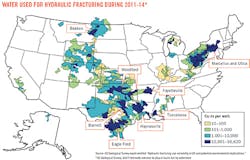The volume of water required to hydraulically fracture wells varies widely on a regional basis across the country, according to the first national analysis and map of hydraulic fracturing water usage detailed in a recent US Geological Survey study.
The analysis was published in Water Resources Research, a journal of the American Geophysical Union. Researchers found water volumes for fracturing varied from 2,600 gal to 9.7 million gal per well.
USGS scientist Tanya J. Gallegos, lead author of the report, told UOGR that the agency didn't delineate water volumes by play or basin but by watershed. Gallegos is based in Reston, Va. The report's other authors were Brian A. Varela and Seth S. Haines, both of the USGS Denver office, and Mark A. Engle, University of Texas at El Paso Department of Geological Sciences.
USGS said its research, entitled "Hydraulic Fracturing Use Variability in US and Potential Environmental Implications," was part of the agency's ongoing effort to understand the requirements and potential environmental consequences of unconventional oil and gas development.
As of 2014, median annual water volume estimates for fracturing in horizontal wells increased to more than 4 million gal for an oil well and 5.1 million gal for a gas well. That compared with an initial average estimate of about 177,000 gal/well for oil and gas wells in 2000, the study said.
"One of the most important things we found was that the amount of water used per well varies quite a bit, even within a single oil and gas basin," said Gallegos. "A better understanding of the volumes of water injected for hydraulic fracturing could be a key to understanding the potential for some environmental impacts."
For its report, USGS researchers used proprietary IHS Inc. information compiled from various public and private sources covering more than 81,800 wells.
USGS said it knew of no way to estimate the absolute number of missing wells. Not all wells completed using fracturing were included, USGS noted, saying many states do not require that operators report fracturing fluid volumes, not all fractured wells use water, and there can be a time lag in IHS updates.
USGS noted that horizontal drilling accounted for the highest average water use for fracturing in 52 out of the 57 watersheds studied. The agency also noted that the watersheds where the most water was used to fracture wells involved shale formations.
Horizontal wells require more water than vertical wells. Generally, water use increased with the length of the laterals, the report said. Reservoir depth and thickness influence the amount of water needed to induce fractures.



